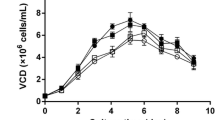Abstract
To elucidate the metabolic characteristics of recombinant CHO cells expressing glutamine synthetase (GS) in the medium with or without glutamine, the concentrations of extra- and intracellular metabolites and the activities of key metabolic enzymes involved in glutamine metabolism pathway were determined. In the absence of glutamine, glutamate was utilized for glutamine synthesis, while the production of ammonia was greatly decreased. In addition, the expression of recombinant protein was increased by 18%. Interestingly, the intracellular glutamine maintained almost constant, independent of the presence of glutamine or not. Activities of glutamate-oxaloacetate aminotransferase (GOT), glutamate-pyruvate aminotransferase (GPT), and glutamate dehydrogenase (GDH) increased in the absence of glutamine. On the other hand, intracellular isocitrate and the activities of its downstream isocitrate dehydrogenase in the TCA cycle increased also. In combination with these two factors, a 8-fold increase in the intracellular α-ketoglutarate was observed in the culture of CHO-GS cells in the medium without glutamine.
Similar content being viewed by others
Abbreviations
- CHO-GS:
-
Recombinant Chinese hamster ovary cell bearing the exogenous glutamine synthetase gene
- GS:
-
Glutamine synthetase
- GOT:
-
Glutamate-oxaloacetate aminotransferase
- GPT:
-
Glutamate-pyruvate aminotransferase
- GDH:
-
Glutamate dehydrogenase
- PAG:
-
Phosphate-activated glutaminase
- C X :
-
Viable cell density
- α-KG:
-
α-Ketoglutarate
- Fum:
-
Fumarate
- Cit:
-
Citrate
- Icit:
-
Isocitrate
- Mal:
-
Malate
- MSX:
-
Methionine sulphoximine
- Q P :
-
Specific production rate of metabolite
- Q S :
-
Specific consumption rate of substrate
- Y P/S :
-
Apparent yield coefficient of product to substrate
- 0:
-
Seeding time
- t:
-
Harvest time
References
Andersen DC, Goochee CF (1995) The effect of ammonia on the O-linked glycosylation of granulocyte colony-stimulating factor produced by Chinese hamster ovary cells. Biotechnol Bioeng 47:96–105
Bergmeyer HU (1983a) Methods of enzymatic analysis, vol III, 3rd edn. Verlag Chemie, Weinheim, Germany
Bergmeyer HU (1983b) Methods of enzymatic analysis, vol IV, 3rd edn. Verlag Chemie, Weinheim, Germany
Bonarius HPJ, Hatzimanikatis V, Meesters KPH, de Gooijer CD, Schmid G, Tramper J (1996) Metabolic flux analysis of hybridoma cells in different culture media using mass balances. Biotechnol Bioeng 50:299–318
Christie A, Butler M (1999) The adaptation of BHK cells to a non-ammoniagenic glutamate-based culture medium. Biotechnol Bioeng 64:298–309
Coleman PS, Lavietes BB (1981) Membrane cholesterol, tumorigenesis and the biochemical phenotype of neoplasia. CRC Crit Rev Biochem 11:341–393
Cockett MI, Bebbington CR, Yarranton GT (1990) High level expression of tissue inhibitor of metalloproteinases in Chinese hamster ovary cells using glutamine synthetase gene amplification. BioTechnol 8:662–667
Dempsey J, Ruddock S, Osborne M, Ridley A, Sturt S, Field R (2003) Improved fermentation processes for NS0 cell lines expressing human antibodies and glutamine synthetase. Biotechnol Prog 19:175–178
Eisenberg D, Gill HS, Pfluegl GMU, Rotstein SH (2000) Structure–function relationships of glutamine synthetase. Biochim Biophys Acta 1477:122–145
Fiorina A, Frigo G, Cucchetti E (1989) Liquid chromatographic analysis of amino acids in protein hydrolysates by post-column derivatization with o-phthaladehyde and 3-mercaptoproropionic acid. J Chromatogr 476:83–92
Fitzpatrick L, Jenkins HA, Butler M (1993) Glucose and glutamine metabolism of a murine B-lymphocyte hybridoma grown in batch culture. Appl Biochem Biotechnol 43:93–116
Hassell T, Butler M (1990) Adaptation to non-ammoniagenic medium and selective substrate feeding leads to enhanced yields in animal cell cultures. J Cell Sci 96:501–508
Kurano N, Leist C, Messi F, Kurano S, Fiechter A (1990) Growth behavior of Chinese hamster ovary cells in a compact loop bioreactor. 2. Effects of medium components and waste products. J Biotechnol 15:113–128
Ljunggren J, Häggström L (1994) Catabolic control of hybridoma cells by glucose and glutamine limited fed batch cultures. Biotechnol Bioeng 44:808–818
Lu S, Sun X, Shi C, Zhang Y (2003) Determination of tricarboxylic acid cycle acids and other related substances in cultured mammalian cells by gradient ion-exchange chromatography with suppressed conductivity detection. J Chromatogr A 1012:161–168
Lu S, Sun X, Zhang Y (2005) Insight into metabolism of CHO cells at low glucose concentration on the basis of the determination of intracellular metabolites. Process Biochem 40:1917–1921
Mancuso A, Sharfstein ST, Tucker SN, Clark DS, Blanch HW (1994) Examination of primary metabolic pathways in a murine hybridoma with carbon-13 nuclear magnetic resonance spectroscopy. Biotechnol Bioeng 44:563–585
Martinelle K, Häggström L (1993) Mechanisms of ammonia and ammonium ion toxicity in animal cells:␣transport across cell membranes. J Biotechnol 30:339–350
Martinelle K, Doverskog M, Jacobsson U, Chapman BE, Kuchel PW, Häggström L (1998) Elevated glutamate dehydrogenase flux in glucose-deprived hybridoma and myeloma cells: evidence from 1H/15N NMR. Biotechnol Bioeng 60:508–517
Meister A (1985) Methods in enzymology, vol 113. Academic Press, New York, pp 158–199
Mercille S, Massie B (1994) Induction of apoptosis in nutrient-deprived cultures of hybridoma and myeloma cells. Biotechnol Bioeng 44:1140–1154
Milman G, Portnoff LS, Tiemeier DC (1975) Immunochemical evidence for glutamine-mediated degradation of glutamine synthetase in cultured Chinese hamster cells. J Biol Chem 250:1393–1399
Schmid G, Keller T (1992) Monitoring hybridoma metabolism in continuous suspension culture at the intracellular level. Cytotechnology 9:217–229
Vriezen N, van Dijken JP (1998) Fluxes and enzyme activities in central metabolism of myeloma cells grown in chemostat culture. Biotechnol Bioeng 59: 28–39
Wurm FM (2004) Production of recombinant protein therapeutics in cultivated mammalian cells. Nat Biotechnol 22:1393–1398
Yallop CA, Nørby PL, Jensen R, Reinbach H, Svendsen I (2003) Characterisation of G418-induced metabolic load in recombinant CHO and BHK cells: effect on the activity and expression of central metabolic enzymes. Cytotechnology 42:87–99
Acknowledgements
This work was supported by the grants from the National High-Tech Research and Development Programs of China (No. 2004AA2Z3792).
Author information
Authors and Affiliations
Corresponding author
Rights and permissions
About this article
Cite this article
Zhang, F., Sun, X., Yi, X. et al. Metabolic characteristics of recombinant Chinese hamster ovary cells expressing glutamine synthetase in presence and absence of glutamine. Cytotechnology 51, 21–28 (2006). https://doi.org/10.1007/s10616-006-9010-y
Received:
Accepted:
Published:
Issue Date:
DOI: https://doi.org/10.1007/s10616-006-9010-y




